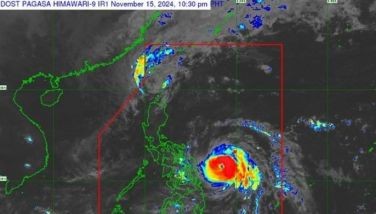Bulacan now exporting pyrotechnics
December 16, 2006 | 12:00am
MALOLOS CITY — The Bulacan pyrotechnics industry goes international.
Jerry Caguingin, an officer of the Investment Promotion Division of the provincial government and member of the Pyrotechnics Regulatory Board, told The STAR that a local pyrotechnics manufacturer based in San Rafael town, Dragon Fireworks, has started exporting its products to Europe.
"They are planning to penetrate the US market next year," Caguingin said after meeting with pyrotechnics manufacturers and dealers last week.
The Philippine pyrotechnics is a P400-million industry with 300 licensed manufacturers and dealers.
In a telephone interview on Thursday, Dragon Fireworks’ Joven Ong confirmed that they have started exporting their products early this year but did not disclose the volume.
"Maliit lang kasi nagsisimula pa lang kami (It’s just small because we are just starting). Hopefully we can expand to more countries next year," Ong said.
He revealed that they have started adopting international standards in their productions since 1992 and have invested as well in technology.
He said it is not true that Philippines is behind in technology in the manufacture of pyrotechnics.
"We are not far behind China, where it was invented centuries ago," he said.
Caguingin said that an official of the Japan External Trade Organization (Jetro) has offered to train local pyrotechnic technicians at Ashikaga University in Japan where a course on scientific production of pyrotechnics is being offered.
"There is also a possibility that Japanese trainers may just come over to help improve the skills of our technicians," he said.
Pyrotechnics originated in China in the first century with the invention of black powder, a combination of potassium nitrate, sulfur and charcoal.
Historians said that from China, the fireworks were brought to the West by adventurous explorers, such as Marco Polo, who brought the invention to the West from one of his many trips to China and other Eastern countries.
Thus, the knowledge of making fireworks spread West, through Arabia in the 7th century AD. The Arabs called the rockets Chinese arrows.
The earliest recorded use of gunpowder in England, and probably the Western world, is by the Franciscan monk Roger Bacon.
Bacon recorded his experiments with a mixture known today as gunpowder. His formula was very low in potassium nitrate because there was no natural source available, but it contained the other two essential ingredients: charcoal and sulfur.
In the Philippines, the pyrotechnics industry was born in the historic province of Bulacan, thus making it unique to the province as it was closely attached to Filipino culture, especially when welcoming the New Year, making Bulacan the country’s pyrotechnics capital.
According to Arcadio "Ka Adiong" Sta. Ana, the industry started as a family business and an underground activity. His grandfather, Valentin Sta. Ana, learned the process of manufacturing fireworks but it was the parish priest of Sta. Maria town who introduced him to pyrotechnics manufacturing in 1867.
Jerry Caguingin, an officer of the Investment Promotion Division of the provincial government and member of the Pyrotechnics Regulatory Board, told The STAR that a local pyrotechnics manufacturer based in San Rafael town, Dragon Fireworks, has started exporting its products to Europe.
"They are planning to penetrate the US market next year," Caguingin said after meeting with pyrotechnics manufacturers and dealers last week.
The Philippine pyrotechnics is a P400-million industry with 300 licensed manufacturers and dealers.
In a telephone interview on Thursday, Dragon Fireworks’ Joven Ong confirmed that they have started exporting their products early this year but did not disclose the volume.
"Maliit lang kasi nagsisimula pa lang kami (It’s just small because we are just starting). Hopefully we can expand to more countries next year," Ong said.
He revealed that they have started adopting international standards in their productions since 1992 and have invested as well in technology.
He said it is not true that Philippines is behind in technology in the manufacture of pyrotechnics.
"We are not far behind China, where it was invented centuries ago," he said.
Caguingin said that an official of the Japan External Trade Organization (Jetro) has offered to train local pyrotechnic technicians at Ashikaga University in Japan where a course on scientific production of pyrotechnics is being offered.
"There is also a possibility that Japanese trainers may just come over to help improve the skills of our technicians," he said.
Pyrotechnics originated in China in the first century with the invention of black powder, a combination of potassium nitrate, sulfur and charcoal.
Historians said that from China, the fireworks were brought to the West by adventurous explorers, such as Marco Polo, who brought the invention to the West from one of his many trips to China and other Eastern countries.
Thus, the knowledge of making fireworks spread West, through Arabia in the 7th century AD. The Arabs called the rockets Chinese arrows.
The earliest recorded use of gunpowder in England, and probably the Western world, is by the Franciscan monk Roger Bacon.
Bacon recorded his experiments with a mixture known today as gunpowder. His formula was very low in potassium nitrate because there was no natural source available, but it contained the other two essential ingredients: charcoal and sulfur.
In the Philippines, the pyrotechnics industry was born in the historic province of Bulacan, thus making it unique to the province as it was closely attached to Filipino culture, especially when welcoming the New Year, making Bulacan the country’s pyrotechnics capital.
According to Arcadio "Ka Adiong" Sta. Ana, the industry started as a family business and an underground activity. His grandfather, Valentin Sta. Ana, learned the process of manufacturing fireworks but it was the parish priest of Sta. Maria town who introduced him to pyrotechnics manufacturing in 1867.
BrandSpace Articles
<
>
- Latest
- Trending
Trending
Latest
Trending
Latest
Recommended




























